
Minimum Gauge for Cord Sets
Ampere Rating
Volts Total Length of Cord in Feet (meters)
120V 25 (7.6) 50 (15.2) 100 (30.5) 150 (45.7)
240V 50 (15.2) 100 (30.5) 200 (61.0) 300 (91.4)
More
Than
Not More
Than
AWG
0 6 18 16 16 14
610 18161412
10 12 16 16 14 12
12 16 14 12 Not Recommended
• Do not place any object on top of the charger or place the charger on a soft surface
that might block the ventilation slots and result in excessive internal heat. Place the
charger in a position away from any heat source. The charger is ventilated through slots in the
top and the bottom of the housing.
• Do not operate the charger with a damaged cord or plug.
• Do not operate the charger if it has received a sharp blow, been dropped or otherwise
damaged in any way. Take it to an authorized service center.
• Do not disassemble the charger; take it to an authorized service center when service
or repair is required. Incorrect reassembly may result in a risk of electric shock, electrocution or
fi re.
• Disconnect the charger from the outlet before attempting any cleaning. This will
reduce the risk of electric shock. Removing the battery pack will not reduce this risk.
• NEVER attempt to connect 2 chargers together.
• The charger is designed to operate on standard 120V household electrical power. Do
not attempt to use it on any other voltage. This does not apply to the vehicular charger.
Chargers
Your tool uses a DEWALT charger. Be sure to read all safety instructions before using your charger.
Consult the chart at the end of this manual for compatibility of chargers and battery packs.
Charging Procedure (Fig. 2)
1. Plug the charger into an appropriate outlet before inserting the battery pack.
2. Insert the battery pack (D) into the charger, as shown in Figure 2, making sure the pack is fully
seated in charger. The red (charging) light will blink continuously, indicating that the charging
process has started.
3. The completion of charge will be indicated by the red light remaining ON continuously. The
pack is fully charged and may be used at this time or left in the charger.
Indicator Light Operation
PACK CHARGING
PACK CHARGED
x
HOT/COLD DELAY
PROBLEM PACK OR CHARGER
PROBLEM POWERLINE
Charge Indicators
This charger is designed to detect certain problems that can arise. Problems are indicated by
the red light fl ashing at a fast rate. If this occurs, re-insert the battery pack into the charger. If the
problem persists, try a different battery pack to determine if the charger is working properly. If the
new pack charges correctly, then the original pack is defective and should be returned to a service
center or other collection site for recycling. If the new battery pack elicits the same trouble indication
as the original, have the charger and the battery pack tested at an authorized service center.
HOT/COLD DELAY
This charger has a hot/cold delay feature: when the charger detects a battery that is hot, it
automatically starts a delay, suspending charging until the battery has cooled. After the battery
has cooled, the charger automatically switches to the pack charging mode. This feature ensures
maximum battery life. The red light fl ashes long, then short while in the hot/cold delay mode.
LEAVING THE BATTERY PACK IN THE CHARGER
The charger and battery pack can be left connected with the charge indicator showing pack
charged.
WEAK BATTERY PACKS: Weak batteries will continue to function but should not be expected
to perform as much work.
FAULTY BATTERY PACKS: This charger will not charge a faulty battery pack. The charger will
indicate faulty battery pack by refusing to light or by displaying problem pack or charger.
NOTE: This could also mean a problem with a charger.
Important Charging Notes
1. Longest life and best performance can be obtained if the battery pack is charged when the air
temperature is between 65°F and 75°F (18° – 24°C). DO NOT charge the battery pack in an
air temperature below +40°F (+4.5°C), or above +105°F (+40.5°C). This is important and will
prevent serious damage to the battery pack.
2. The charger and battery pack may become warm to the touch while charging. This is a normal
condition, and does not indicate a problem. To facilitate the cooling of the battery pack after
use, avoid placing the charger or battery pack in a warm environment such as in a metal shed
or an uninsulated trailer.
3. A cold battery pack will charge at about half the rate of a warm battery pack. The battery
pack will charge at that slower rate throughout the entire charging cycle and will not return to
maximum charge rate even if the battery pack warms.
4. If the battery pack does not charge properly:
a. Check operation of receptacle by plugging in a lamp or other appliance;
b. Check to see if receptacle is connected to a light switch which turns power off when you
turn out the lights;
c. Move the charger and battery pack to a location where the surrounding air temperature is
approximately 65°F – 75°F (18° – 24°C);
d. If charging problems persist, take the tool, battery pack and charger to your local service
center.
5. The battery pack should be recharged when it fails to produce suffi cient power on jobs which
were easily done previously. DO NOT CONTINUE to use under these conditions. Follow the
charging procedure. You may also charge a partially used pack whenever you desire with no
adverse effect on the battery pack.
6. Foreign materials of a conductive nature such as, but not limited to, grinding dust, metal chips,
steel wool, aluminum foil, or any buildup of metallic particles should be kept away from charger
cavities. Always unplug the charger from the power supply when there is no battery pack in the
cavity. Unplug the charger before attempting to clean.
7. Do not freeze or immerse the charger in water or any other liquid.
WARNING: Shock hazard. Don’t allow any liquid to get inside the charger. Electric shock may
result.
WARNING: Burn hazard. Do not submerge the battery pack in any liquid or allow any liquid
to enter the battery pack. Never attempt to open the battery pack for any reason. If the plastic
housing of the battery pack breaks or cracks, return to a service center for recycling.
Storage Recommendations
1. The best storage place is one that is cool and dry, away from direct sunlight and excess heat
or cold.
2. For long storage, it is recommended to store a fully charged battery pack in a cool dry place
out of the charger for optimal results.
NOTE: Battery packs should not be stored completely depleted of charge. The battery pack will
need to be recharged before use.
SAVE THESE INSTRUCTIONS FOR FUTURE USE
COMPONENTS (Fig. 1, 3)
WARNING: Never modify the worklight or any part of it. Damage or personal injury could result.
A. Switch F. Lens cover assembly
B. Hang hook G. Belt hook screw
C. Pivoting head H. Belt hook (optional accessory)
D. Battery pack I. Fuel gauge button (Fig. 3)
E. Battery release button
OPERATION
WARNING: To reduce the risk of serious personal injury, turn worklight off and
disconnect battery pack before making any adjustments or removing/installing
attachments or accessories.
WARNING: Burn hazard. Lens becomes hot during use. Do not touch lens surface when
worklight is on or immediately after use.
Installing and Removing the Battery Pack (Fig. 3)
WARNING: To reduce the risk of injury, never depress the battery release button without
removing the battery pack. Depressing the battery release button without removing the battery
pack can result in the battery pack falling out unexpectedly.
NOTE: For best results, make sure your battery pack is fully charged.
To install the battery pack (D) into the tool handle, align the battery pack with the rails inside the
tool’s handle and slide it into the handle until the battery pack is fi rmly seated in the tool and ensure
that it does not disengage.
To remove the battery pack from the tool, press the release button (E) and fi rmly pull the battery
pack out of the tool handle. Insert it into the charger as described in the charger section of this
manual.
Consult the chart at the end of this manual for compatibility of chargers and battery packs.
FUEL GAUGE BATTERY PACKS (FIG. 3)
Some DEWALT battery packs include a fuel gauge which consists of three green LED lights that
indicate the level of charge remaining in the battery pack.
FIG. 1
To actuate the fuel gauge, press and hold the fuel gauge button (I). A combination of the three
green LED lights will illuminate designating the level of charge left. When the level of charge in the
battery is below the usable limit, the fuel gauge will not illuminate and the battery will need to be
recharged.
NOTE: The fuel gauge is only an indication of the charge left on the battery pack. It does not
indicate tool functionality and is subject to variation based on product components, temperature
and end-user application.
For more information regarding fuel gauge battery packs, please call 1-800-4-D
EWALT
(1-800-433-9258) or visit our website www.dewalt.com.
Switch (Fig. 1)
The worklight has a high beam and low beam setting. Press the switch (A) once for high beam,
twice for low beam, and a third time to turn the worklight off.
Low Battery Indicator
NOTE: The light will run up to 9 hours on the high setting and 17 hours on the low setting on a
single battery charge using the DCB204 20V Max* battery. Using batteries with lower capacity will
produce less run time.
As the battery nears a fully discharged state, the worklight will blink twice and then dim, dropping
the brightness of the light below the normal level. The light will continue to blink twice every 45
seconds until the battery is fully discharged at which time the light will turn off. Indication time will
vary based on battery pack capacity and the light setting.
Pivoting Head (Fig. 1)
The pivoting head rotates in nine positions ranging from 0°–140°.
Carrying and Suspending the Worklight (Fig. 1, 4)
CAUTION: When the worklight hangs by the belt hook or hang hook, do not shake the worklight
or the object from which it hangs. Do not hang the worklight from any electrical wires or anything
that is not secure. Personal injury or property damage may occur.
CAUTION: Only use the belt hook or the hang hook for hanging the LED worklight. The belt
hook and hang hook are not intended to support additional weight. Do not attach or hang anything
additional to the worklight or risk of breakage may occur.
CAUTION: Do not use the belt hook or hang hook to reach with or to support your weight
in any situation.
HANG HOOK (FIG. 4)
The built-in hang hook (B) telescopes out of the lens cover assembly (F). The hang hook locks
into place in the down position and when fully extended, as shown in Figure 4. The hook rotates
360 degrees.
BELT HOOK (OPTIONAL ACCESSORY) (FIG. 1)
WARNING: To reduce the risk of serious personal injury, ensure the screw holding the belt
hook is secure.
IMPORTANT: When attaching or replacing the belt hook (H), use only the screw (G) that is
provided. Be sure to securely tighten screw.
The belt hook (H) can be be attached to either side of the worklight using only the screw (G)
provided, to accommodate left- or right-handed users.
To move belt hook, remove the screw (G) that holds the belt hook in place, then reassemble on the
opposite side. Be sure to securely tighten screw.
MAINTENANCE
WARNING: To reduce the risk of serious personal injury, turn worklight off and
disconnect battery pack before making any adjustments or removing/installing
attachments or accessories.
• Do not attempt to repair the worklight. To assure product safety and reliability, repairs,
maintenance, and adjustments should be performed by authorized D
EWALT service centers.
Cleaning
WARNING: Never use solvents or other harsh chemicals for cleaning the non-metallic parts
of the tool. These chemicals may weaken the plastic materials used in these parts. Use a cloth
dampened only with water and mild soap. Never let any liquid get inside the tool; never immerse
any part of the tool into a liquid.
CHARGER CLEANING INSTRUCTIONS
WARNING: Shock hazard. Disconnect the charger from the AC outlet before cleaning. Dirt and
grease may be removed from the exterior of the charger using a cloth or soft non-metallic brush.
Do not use water or any cleaning solutions.
Accessories
WARNING: Since accessories, other than those offered by DEWALT, have not been tested with
this product, use of such accessories with this tool could be hazardous. To reduce the risk of injury,
only D
EWALT recommended accessories should be used with this product.
Recommended accessories for use with your tool are available at extra cost from your local dealer
or authorized service center. If you need assistance in locating any accessory, please contact
D
EWALT Industrial Tool Co., 701 East Joppa Road, Baltimore, MD 21286, call 1-800-4-DEWALT
(1-800-433-9258) or visit our website: www.dewalt.com.
Repairs
The charger and battery pack are not serviceable.
To assure product SAFETY and RELIABILITY, repairs, maintenance and adjustment (including
brush inspection and replacement) should be performed by a D
EWALT factory service center,
a DEWALT authorized service center or other qualifi ed service personnel. Always use identical
replacement parts.
Register Online
Thank you for your purchase. Register your product now for:
• WARRANTY SERVICE: Registering your product will help you obtain more effi cient warranty
service in case there is a problem with your product.
• CONFIRMATION OF OWNERSHIP: In case of an insurance loss, such as fi re, fl ood or theft,
your registration of ownership will serve as your proof of purchase.
• FOR YOUR SAFETY: Registering your product will allow us to contact you in the unlikely
event a safety notifi cation is required under the Federal Consumer Safety Act.
Register online at www.dewalt.com/register.
FIG. 2
D
B
C
E
A
D
F
G
H
FIG. 3
E
FIG. 4
B
I
D

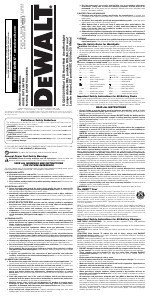


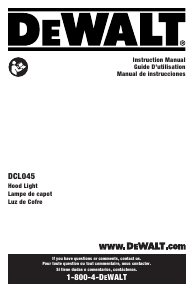
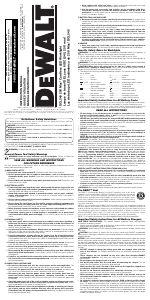
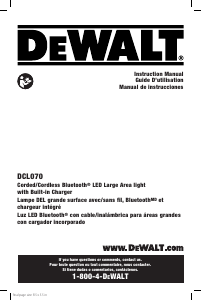
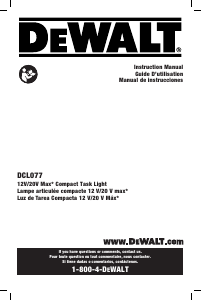
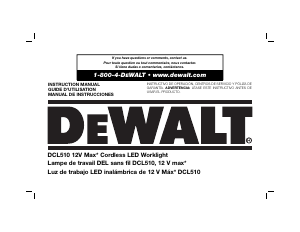
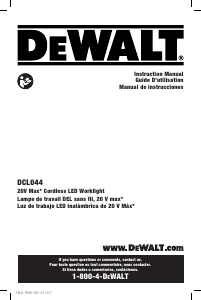
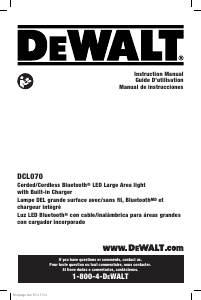
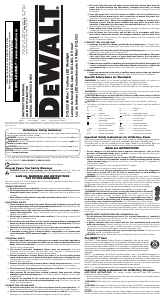
Praat mee over dit product
Laat hier weten wat jij vindt van de DeWalt DCL050 Lamp. Als je een vraag hebt, lees dan eerst zorgvuldig de handleiding door. Een handleiding aanvragen kan via ons contactformulier.